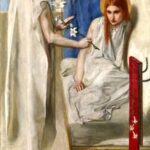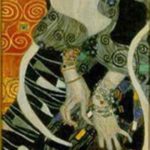Francis Bacon entered my life when I was about ten or twelve years old, via Charles Wentinck’s The Art Treasures of Europe.1 The book includes a full-page reproduction of Two Figures (1953), which I found simultaneously captivating and unsettling. The painting depicts two male nudes in the act of coupling; at the time, I’m not even sure I realized both were men, but a few years later I would learn that the bottom figure is a self-portrait. By the time I graduated from high school I had gained, courtesy of the Sacramento Public Library system, a working knowledge of Bacon’s oeuvre. I would also soon read David Sylvester’s engrossing book of interviews with him – it is a volume which continues to be a fascinating and revealing document of the creative process.2
In 1990, a large general survey of Bacon’s work came to the Los Angeles County Museum of Art. Although he had been an artistic icon of mine for many years by then, I had only seen a few actual paintings and was thus very much looking forward to the exhibition. Unfortunately, because of reasons not really appropriate to go into here, my plans fell through.3 Shortly afterward, I came into possession of the exhibition catalogue and found that Study after Velasquez’s Portrait of Pope Innocent X (1953), one of my favorite paintings ever, had been in the show. It alone would have been worth the trip, and it is to my eternal regret that I did not make it to LA during the exhibition’s run.
In the summer of 1999, the Palace of the Legion of Honor in San Francisco hosted Francis Bacon: A Retrospective, and I was finally able to see a large show of his work. The aforementioned 1953 Innocent X was not part of this exhibition,4 but that was ultimately not a concern – my museum-going companion for this excursion sidled up to me while I was taking in a different pope painting and informed me my mouth was hanging open. “I’d never thought of the term ‘jaw-dropping’ as literal before,” she later said.
Bacon’s varied subjects – the popes; the agitated, solitary, suited men; the biomorphic, often headless forms; the arresting portrait triptychs; the enigmatic, multi-figure tableaus; et al. – were all represented. His turbulent subject matter would be notable even if his technique had been more traditional, but the immediacy of his abstract mark-making in the service of recording that imagery is what gives the work much of its power. His sense of formalism in both composition and presentation – he preferred the paintings be in wide, gilded frames and under glass – adds to this duality of deeply ordered work which appears to have been made largely through improvisational means.
All these years after Bacon’s painting became a formative element in my artistic development, I still find his work viscerally affecting and, with the possible exception of Willem de Kooning’s, perhaps the strongest painting oeuvre of the twentieth century. Francis Bacon died of a heart attack at eighty-two while on a trip to Madrid in 1992. Back in his studio in London’s South Kensington, a canvas sat on the easel, unfinished.
1 Simon & Schuster (1974).
2 The copy I eventually purchased in the late 1980s was The Brutality of Fact: Interviews with Francis Bacon/Third enlarged edition; Thames and Hudson (1988).
3 Those plans involved an attractive young woman who lived in Los Angeles. With her boyfriend.
4 Study after Velasquez’s Portrait of Pope Innocent X was exhibited in California in 1999, at San Diego’s Museum of Contemporary Art. I didn’t become aware of the show The Papal Portraits of 1953, which was comprised of twelve Bacon canvases, until after it closed. Maybe one day I’ll make it to the Des Moines Art Center to see the piece and finally put the feeling of missing out to rest. At least concerning the painting.

![Francis Bacon: Three Studies of the Human Head [Right panel] (1953).](https://i0.wp.com/coreyokada.com/wp-content/uploads/2021/03/francis_bacon-three_studies_of_the_human_head_1953_right_panel.jpg?w=176&h=176&crop=1&ssl=1)
![Francis Bacon: Three Studies of Muriel Belcher [Left panel] (1966).](https://i0.wp.com/coreyokada.com/wp-content/uploads/2021/03/francis_bacon_three_studies_of_muriel_belcher_1966_left_panel.jpg?w=176&h=176&crop=1&ssl=1)
![Francis Bacon: Tripych Inspired by the Oresteia of Aeschylus [Middle panel] (1981).](https://i0.wp.com/coreyokada.com/wp-content/uploads/2021/03/francis_bacon_triptych_inspired_by_the_oresteia_of_aeschylus_1981_middle_panel.jpg?w=176&h=176&crop=1&ssl=1)




